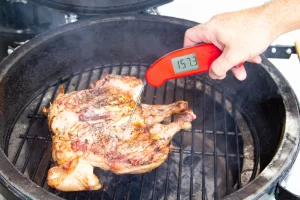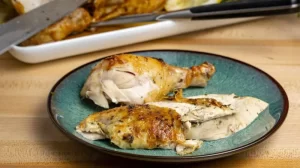The Perfect Temperature at Which Chicken is Done
Temperature at Which Chicken is Done
The temperature at which chicken is done and safe to eat is typically 165°F (73.9°C). It’s essential to measure the internal temperature of the thickest part of the chicken, avoiding contact with bones, to ensure it has reached this temperature. The temperature at which chicken is considered done and safe to eat depends on the part of the chicken you are cooking.
In the world of culinary arts, mastering the art of cooking chicken to perfection is a skill that every chef, home cook, or barbecue enthusiast aspires to achieve. The key to a juicy, flavorful chicken dish lies in knowing the precise temperature at which chicken is done. In this article, we will delve into the depths of poultry perfection, exploring the science, methods, and techniques to ensure your chicken is always cooked to perfection.
Here are some general guidelines for chicken doneness temperatures:
Chicken Breasts: The internal temperature of chicken breasts should reach 165°F (73.9°C). Use a food thermometer to check the thickest part of the breast, making sure it has reached this temperature. At 165°F, the chicken is fully cooked and safe to eat. Discover more about Wooden Cooking Utensils
Chicken Thighs, Wings, and Drumsticks: These dark meat portions of the chicken can be cooked to a slightly lower temperature, around 170°F (76.7°C). Again, use a food thermometer to ensure the meat has reached this temperature.
Whole Chicken: When roasting a whole chicken, it’s a good idea to aim for an internal temperature of 165°F (73.9°C) in the thickest part of the thigh, as this is the slowest-cooking part of the bird. The breast may slightly exceed this temperature.
The Importance of Cooking Chicken Thoroughly
Before we get into the nitty-gritty of chicken temperatures, let’s understand why cooking chicken thoroughly is crucial. Chicken is notorious for harboring harmful bacteria, such as Salmonella and Campylobacter, which can lead to foodborne illnesses if not adequately eliminated during cooking. Ensuring that your chicken reaches the proper internal temperature is your first line of defense against these pathogens.
Different Parts, Different Temperatures
Chicken comprises various parts, each with its unique texture and ideal temperature for doneness. Here’s a breakdown of the most common chicken cuts and their recommended internal temperatures: Also read about Cooking Methods
Whole Chicken (Roast or Grill)
- The breast should reach an internal temperature of 165°F (73.9°C).
- H2: The thigh and leg should reach an internal temperature of 175°F (79.4°C).
Chicken Breasts
- Boneless, skinless chicken breasts should reach an internal temperature of 165°F (73.9°C).
Chicken Thighs
- Chicken thighs, bone-in or boneless, should reach an internal temperature of 175°F (79.4°C).
The Role of Carryover Cooking
Carryover cooking is a phenomenon where the internal temperature of meat continues to rise even after it’s removed from the heat source. For this reason, it’s essential to account for carryover cooking when determining the ideal temperature for your chicken.

Methods for Checking Temperature
Using a Meat Thermometer
- A reliable meat thermometer is an indispensable tool for any cook. Insert it into the thickest part of the chicken without touching the bone to get an accurate reading.
Visual Indicators
- For experienced chefs, visual cues like golden brown skin and clear juices can also indicate doneness.
Cooking Techniques for Perfect Chicken
Roasting
- Roasting chicken in the oven is a classic method. Use a roasting pan, and remember to baste for extra flavor.
Grilling
- Grilled chicken imparts a smoky flavor. Keep a close eye to prevent overcooking.
Pan-Frying
- Pan-frying is perfect for crispy chicken. Use a cast-iron skillet for the best results.
Sous Vide
- Sous vide cooking ensures consistent results. Seal the chicken in a bag and let it cook in a water bath.
Achieving Juiciness and Flavor
Brining
- Brining chicken in a saltwater solution before cooking can enhance moisture and flavor.
Marinades and Rubs
- Experiment with marinades and rubs to infuse your chicken with exciting flavors.
Tips for Chicken Perfection
Now that you understand the temperature at which chicken is done, the basics, let’s dive into some expert tips to elevate your chicken dishes to culinary perfection.
Seasoning is Key
Before cooking, be generous with your seasoning. Whether you prefer a simple salt and pepper rub or a complex marinade, seasoning adds depth and flavor to your chicken.
Use a Meat Thermometer
Investing in a good-quality meat thermometer is a game-changer for cooking chicken. It takes the guesswork out of determining the internal temperature, ensuring your chicken is cooked perfectly without risk.
Truss, Your Chicken
If you’re roasting a whole chicken, consider trussing it. Trussing involves tying the legs and wings together, which helps the chicken cook more evenly and maintain its shape.
Consider Different Cuts
Different cuts of chicken require different cooking times and techniques. For example, chicken breasts cook faster than thighs. Adjust your cooking method accordingly to avoid overcooking or undercooking. We can’t emphasize this enough – let your chicken rest! Cover it loosely with foil after removing it from the heat and let it sit for at least 5-10 minutes. This allows the juices to redistribute, resulting in a moist and delicious meal.

Experiment with Flavors
Chicken is incredibly versatile, so feel free to experiment with various seasonings, sauces, and marinades. Whether you prefer sweet and tangy, spicy, or savory, there’s a flavor profile for everyone.
Conclusion
In conclusion, achieving the perfect temperature at which chicken is done is the key to serving a delicious and safe meal. Whether you prefer your chicken roasted, grilled, or pan-fried, knowing the proper internal temperatures and cooking techniques will elevate your culinary skills.
Now that you’re armed with this knowledge, go forth and cook with confidence, ensuring that every chicken dish you prepare is a masterpiece of flavor and safety.
FAQs
1. What happens if I don’t cook chicken to the recommended temperature?
If you don’t cook chicken to the recommended temperature, harmful bacteria can survive, leading to foodborne illnesses. It’s essential to prioritize food safety.
2. Can I eat slightly pink chicken?
Chicken should never be eaten if it’s pink or has bloody juices. Always ensure it reaches the recommended internal temperature to be safe for consumption.
3. Is it necessary to rest the chicken after cooking?
Resting chicken after cooking allows the juices to redistribute, ensuring a juicier result. It’s a good practice but not mandatory.
4. What’s the best way to check a chicken’s temperature without a thermometer?
While a meat thermometer is the most accurate method, you can also check by making a small incision. The chicken is done if the juices run clear, not pink.
5. How long can I safely store cooked chicken in the refrigerator?
Cooked chicken can be safely stored in the refrigerator for 3-4 days. Be sure to use an airtight container to maintain freshness.
